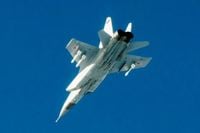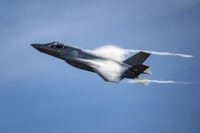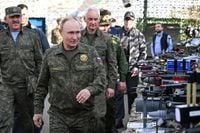In a month marked by rising tensions and a flurry of military activity, NATO and its member states have found themselves at the center of a renewed contest over airspace security with Russia. From Alaska’s icy skies to the Baltic’s tense borders, a series of unprecedented Russian incursions has forced the alliance to reassess its readiness, test its chain of command, and confront a barrage of political and military provocations that have left both policymakers and the public on edge.
It all began overnight on September 24–25, 2025, when U.S. and Canadian aircraft scrambled after radar tracked two Russian Tu-95 bombers, flanked by two Su-35 fighters, operating inside the Alaskan Air Defense Identification Zone (ADIZ). According to North American Aerospace Defense Command (NORAD), the Russian aircraft never breached U.S. airspace, but the response was anything but routine: an E-3 surveillance plane, four F-16s, and four KC-135 tankers were launched to shadow the formation. NORAD described the event as part of a familiar pattern, emphasizing that the aircraft remained in international airspace and posed no direct threat. Yet, the scale and timing of the operation underscored the seriousness with which such encounters are now treated, especially as similar incidents play out across NATO’s European frontiers.
Just days earlier, on September 19, Estonia reported a brazen breach of its own airspace. Three Russian MiG-31s crossed into Estonian territory near the island of Vaindloo, their transponders off and radios silent. Italian F-35s, deployed to Ämari as part of NATO’s Baltic Air Policing rotation, scrambled to intercept. The Russian jets lingered for about 12 minutes—an eternity in the world of air defense—before being escorted out. Estonia’s foreign minister called the incursion “unprecedently brazen,” while Russia denied the episode ever took place. The incident prompted Tallinn to invoke Article 4 of the Washington Treaty, requesting urgent consultations with its allies. The breach, brief as it was, carried weight: it was a deliberate test, said NATO officials, of allied response times and procedures.
Estonia was not alone in facing Russian provocations. On the night of September 9–10, Poland reported that at least 19 Russian drones violated its airspace, triggering a series of air defense engagements and temporary closures. According to Polish authorities, about 20 drones flew deep into Polish territory, with some shot down by NATO jets and others crashing on their own. This marked the first direct military engagement between the alliance and Russia since Moscow’s full-scale invasion of Ukraine in 2022. Romania and Latvia also reported single Russian drone violations in September, further highlighting the breadth of the campaign.
The motives behind these incursions have sparked intense debate. Some Western officials and analysts see a Kremlin strategy of “coercive signaling”—a way to test NATO’s willingness to defend its members and to probe for weaknesses or indecision. As Mark Galeotti, head of Mayak Intelligence, put it on a podcast, “This is Moscow trying to say, ‘Just look how dangerous things already are and how dangerous they could get. Remember we are more daring, willful, reckless, resolute—use whatever adjective you want, but the point is, we are more of it.’” Others, like Estonian Defense Minister Hanno Pevkur, argue that Russia hopes to force NATO to divert air defense assets from Ukraine to its own borders. “Russia is trying to tear us out from Ukraine,” Pevkur said, suggesting that the incursions are designed to sap Western resolve and resources.
These provocations come at a time when Russia’s battlefield fortunes in Ukraine remain mixed, but its rhetoric toward NATO has grown sharper. Before its 2022 invasion, Moscow demanded that NATO renounce any plans for Ukrainian membership and roll back troop deployments near Russia’s borders—demands the alliance flatly rejected. President Vladimir Putin has since warned that any Western-enabled strikes inside Russia could prompt Moscow to target military facilities in NATO countries. The risk of escalation is real, but as recent events show, both sides are walking a fine line between deterrence and provocation.
NATO’s response has been measured but firm. After the drone swarm over Poland, Warsaw triggered a NATO mechanism allowing any member to demand a full meeting if it believes its territorial integrity is threatened. The alliance quickly moved to bolster air defenses along its eastern flank, launching more surveillance sorties and quick-reaction alert (QRA) launches. Italian F-35s in the Baltics reported seven scrambles since early August, the most recent tied to the Estonian breach. The operational model is clear: pilots fly NATO missions, but the decision to release weapons remains a national prerogative, creating a layered command structure designed to balance speed and democratic oversight.
The political debate is heating up. Some allies are pushing to codify tighter standing rules for defensive action over NATO territory, including clearer authority for cross-border engagement and pre-delegation of limited “weapons free” conditions. Advocates say such changes would reduce ambiguity and accelerate reaction times in the face of fast-moving drone or missile threats. Critics warn that rigid thresholds could be exploited by adversaries seeking to manufacture incidents or create political dilemmas. As The Telegraph reported, even a few seconds of cockpit theater—a wing rock here, an exaggerated wave there—can force split-second decisions with far-reaching consequences.
Recent comments from senior leaders have only added to the drama. On September 25, Russian Ambassador to France Oleksiy Meshkov warned that shooting down a Russian fighter jet by NATO would trigger war between the alliance and Russia. Andriy Kovalenko, head of Ukraine’s Center for Countering Disinformation, dismissed these threats as empty propaganda, pointing to the 2015 incident when a Turkish F-16 shot down a Russian Su-24M bomber over Turkish airspace without sparking a wider conflict. “The Russians lie that war will begin if NATO countries shoot down their plane in NATO airspace. They are just very afraid that this will happen, because they will not start a war. Because NATO has already shot down a Russian plane before. It was Turkey, a NATO country. And nothing happened. The Russians are just empty talkers,” Kovalenko said, urging NATO to stand firm and respond to provocations without fear.
On the alliance side, the debate over how to respond has played out in public. Polish Prime Minister Donald Tusk declared that Poland would “without discussion” shoot down any object entering its territory. NATO Secretary-General Mark Rutte echoed this tough stance, stating that decisions on firing at intruding aircraft would depend on available intelligence regarding the threat. U.S. President Donald Trump, who initially suggested the Russian drone intrusion into Poland “could have been a mistake,” later affirmed that NATO should shoot down intruding Russian aircraft, though he stopped short of promising direct U.S. military involvement in such a scenario.
Behind the scenes, the change in NATO’s senior command is also shaping the alliance’s posture. On July 4, U.S. Air Force General Alexus G. Grynkewich took over as Supreme Allied Commander Europe (SACEUR), tasked with translating political guidance into operational orders and ensuring readiness against increasingly complex air and missile threats. Grynkewich has emphasized adaptability and rapid response—qualities now being tested in real time.
Ultimately, the recent flurry of Russian incursions has pushed the debate over NATO’s rules of engagement and deterrence from the realm of policy papers to the front lines of European security. The challenge now is to strike a balance: to signal resolve without triggering escalation, to adapt procedures for a new era of drone and missile warfare, and to reassure member states that the alliance remains united, vigilant, and ready to defend every inch of its territory.
As the world watches, the next move—whether in the skies over Alaska, the Baltics, or Poland—could set the tone for the months and years ahead.


